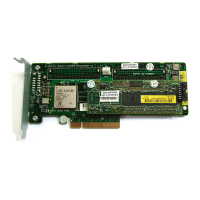The Smart Array
The Smart ArrayThe Smart Array
The Smart Array
Advantage
AdvantageAdvantage
Advantage
HP's innovative design and integration work of the Smart Array family of products creates customer value
that is unmatched in the industry. Use of Smart Array products across multiple applications results in a
much lower Total Cost of Ownership (TCO) than any other server storage RAID product. The HP Smart
Array family brings an unparalleled return on investment through:
Data Compatibility
Data Compatibility Data Compatibility
Data Compatibility
among all models of Smart Array controllers allows simple and easy upgrades any
time needs for higher performance, capacity, and availability increase. Even successive generations of
Smart Array controllers understand the data format of other Smart Array Controllers.
Consistent Configuration and Management Tools
Consistent Configuration and Management ToolsConsistent Configuration and Management Tools
Consistent Configuration and Management Tools
. All Smart Array products utilize a standard set of
management and utility software. These tools minimize Total Cost of Ownership (TCO) by reducing
training requirements and technical expertise necessary to install and maintain the HP server storage.
Universal Hard Drive
Universal Hard Drive Universal Hard Drive
Universal Hard Drive
form factor is for use across multiple HP servers, disk enclosures and storage
systems. With compatibility across many enterprise platforms, you are free to deploy and re-deploy these
drives to quickly deliver increased storage capacity, migrate data between systems, and easily manage
spare drives.
Pre-Failure Warranty
Pre-Failure Warranty Pre-Failure Warranty
Pre-Failure Warranty
means HP Insight Manager not only reports when a drive is going to fail but allows
replacement of failing drives prior to actual failure. For complete details, consult the HP Support Center
or refer to your HP Server documentation.
Key Features
Key FeaturesKey Features
Key Features
The SA-P400 Controller supports up to 18 drives depending on the server implementation. The
SA-P400i Controller supports up to 6 drives depending on the server implementation
Seamless upgrades from past generations and upgrades to next generation HP high performance
and high capacity Serial Attached SCSI Smart Array controllers.
3G SAS technology delivers high performance and data bandwidth up to 300 MB/s per physical
link and contains full compatibility with 1.5G SATA technology.
x8 2.5G PCI Express host interface technology delivers high performance and data bandwidth up
to 2 GB/s maximum bandwidth.
Modular, easy-to-upgrade design lets you optimize performance by upgrading from 40-bit 256MB
cache to 72-bit 512MB battery-backed write cache (BBWC).
Addition of the battery backed cache upgrade enables BBWC, RAID 6 with ADG, array expansion,
logical drive extension, RAID migration, and stripe size migration.
Mix-and-match SAS and SATA hard drives, lets you deploy drive technology as needed to fit your
computing environment.
Software consistency among all Smart Array family products: Array Configuration Utility (ACU),
Option ROM Configuration for Arrays (ORCA), Systems Insight Manager, Array Diagnostic Utility
(ADU) and SmartStart.
Support for up to 2TB in a single logical drive.
Low-profile PCI Express form factor - ships with a full size bracket for deployment in either a low-
profile or full sized slot.
Management Features
Management FeaturesManagement Features
Management Features
Online array expansion (with BBWC upgrade)
Online logical drive extension (with BBWC upgrade)
Online RAID level migration (with BBWC upgrade)
Online strip size migration (with BBWC upgrade)
Offline Mirror splitting and recombining
Unlimited global online spare assignment
User selectable expand and rebuild priority
User selectable RAID level and stripe size
User selectable read and write cache sizes
QuickSpecs
HP Smart Array P400 Controller
HP Smart Array P400 ControllerHP Smart Array P400 Controller
HP Smart Array P400 Controller
Standard Features
DA - 12400 Worldwide — Version 9 — March 26, 2007
Page 3

